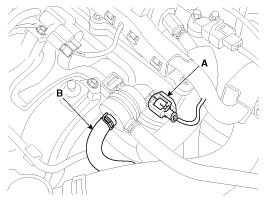Kia Cee'd: Evaporative Emission Control System / Repair procedures
Kia Cee'd JD Service Manual / Emission Control System / Evaporative Emission Control System / Repair procedures
| Inspection |
[System Inspection]
| 1. |
Disconnect the vapor hose from the throttle body and connect a vacuum
pump to the nipple on the throttle body.
|
| 2. |
Check the following points with applied vacuum using a vacuum pump.
· At Cold Engine [Engine Coolant Temperature < 60°C(140°F)]
· At Warmed Engine [Engine Coolant Temperature > 80°C(176°F)]
|
[PCSV Inspection]
| 1. |
Turn ignition switch OFF and disconnect the negative (-) battery cable.
|
| 2. |
Disconnect the PCSV connector (A).
|
| 3. |
Disconnect the vapor hose (B) which is connected to the intake manifold
from the PCSV.
|
| 4. |
After connecting a vacuum pump to the nipple, apply vacuum.
|
| 5. |
With the PCSV control line grounded, check the valve operation with
battery voltage applied to the PCSV(Open) and removed(Closed).
|
| 6. |
Measure the coil resistance of the PCSV.
|
 Schematic diagrams
Schematic diagrams
Schematic Diagram
Canister
Canister is filled with charcoal and absorbs evaporated vapor in fuel tank.
The gathered fuel vapor in canister is drawn into the intake manifold ...
 Canister Repair procedures
Canister Repair procedures
Removal
1.
Turn the ignition switch OFF and disconnect the negative (-) battery
cable.
2.
Remove the fuel tank assembly.
(Ref ...
Other information:
Kia Cee'd JD Service Manual: Rear Transverse Trim Repair procedures
Replacement
•
Put on gloves to protect your hands.
•
Use ...
Kia Cee'd JD Service Manual: Crash Pad Side Cover Repair procedures
Replacement
[LH]
•
When prying with a flat-tip screwdriver, wrap it with protective
tape, and apply protective tape around the related parts, to
prevent damage.
...
© 2017-2025 www.kceed.com


